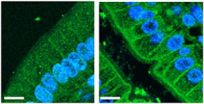(Press-News.org) PROVIDENCE, R.I. [Brown University] — We may not be able control the weather outside, but thanks to a new algorithm being developed by Brown University computer scientists, we can control it in photographs.
The new program enables users to change a suite of "transient attributes" of outdoor photos — the weather, time of day, season, and other features — with simple, natural language commands. To make a sunny photo rainy, for example, just input a photo and type, "more rain." A picture taken in July can be made to look a bit more January simply by typing "more winter." All told, the algorithm can edit photos according to 40 commonly changing outdoor attributes.
The idea behind the program is to make photo editing easy for people who might not be familiar with the ins and outs of complex photo editing software.
"It's been a longstanding interest on mine to make image editing easier for non-experts," said James Hays, Manning Assistant Professor of Computer Science at Brown. "Programs like Photoshop are really powerful, but you basically need to be an artist to use them. We want anybody to be able to manipulate photographs as easily as you'd manipulate text."
A paper describing the work will be presented next week at SIGGRAPH, the world's premier computer graphics conference. The team is continuing to refine the program, and hopes to have a consumer version of the program soon. The paper is available at http://transattr.cs.brown.edu/. Hays's coauthors on the paper were postdoctoral researcher Pierre-Yves Laffont, and Brown graduate students Zhile Ren, Xiaofeng Tao, and Chao Qian.
Editing by machine learning
Changing the weather in a photo involves much more than simply turning a blue sky gray. There are subtle changes in color and contrast that happen across the entire photo — changes that would normally require a skilled photo editor to fully replicate. This new algorithm uses machine learning to make all those subtle changes in one swoop.
To start the project, Hays and his team defined a list of transient attributes that users might want to edit. They settled on 40 attributes that range from the simple — cloudy, sunny, snowy, rainy, or foggy — to the subjective — gloomy, bright, sentimental, mysterious, or calm.
The next step was to teach the algorithm what these attributes look like. To do that, the researchers compiled a database consisting of thousands of photos taken by 101 stationary webcams around the world. The cameras took pictures of the same scenes in varying of conditions — different times of day, different seasons and in all kinds of weather. The researchers then asked workers on Mechanical Turk — a crowdsourcing marketplace operated by Amazon — to annotate more than 8,000 photos according to which of the 40 attributes are present in each. Those annotated photos were then fed through a machine learning algorithm.
"Now the computer has data to learn what it means to be sunset or what it means to be summer or what it means to be rainy—or at least what it means to be perceived as being those things," Hays explained.
Armed with the knowledge of what each attribute looks like, the algorithm can apply that knowledge to new photos. It does so by making what Hays refers to as "local color transforms." It splits the picture into regions — clusters of pixels — and draws on the database to determine how colors in those regions should change with a given attribute.
"If you wanted to make a picture rainier, the computer would know that parts of the picture that look like sky need to become grayer and flatter," Hays explained. "In regions that look like ground, the colors become shinier and more saturated. It does this for hundreds of different regions in the photo."
The results are pretty convincing. In a lab study, the researchers asked participants to rate the manipulated photos on how well they expressed given attributes. The participants preferred the new results around 70 percent of the time compared to the output of traditional approaches to automated editing that make more uniform color changes across the entire photo.
There are limitations to what the program can do at this point, however. It can't reproduce attributes that require new structures to be added to the photo. "We can't turn winter into summer generally, because that would involve adding structure—putting grass where there's snow," Hays said. "We can't synthesize that detail at this point."
Nonetheless, Hays says he's pleased that advances in his field of computer vision have helped to make this kind of application possible.
"To be able to manipulate an image better, you need to be able to understand the image better — to understand the material objects in the image and the boundaries of those objects," he said. "All the progress in computer vision helps us do these things, and enables this progress in image editing."
INFORMATION:
The research was supported by the Intelligence Advanced Research Projects Activity (IARPA) via Air Force Research Laboratory, contract FA8650-12-C-7212, and the National Science Foundation.
Photo editing algorithm changes weather, seasons automatically
2014-08-08
ELSE PRESS RELEASES FROM THIS DATE:
Natural light in office boosts health
2014-08-08
CHICAGO -- Office workers with more light exposure at the office had longer sleep duration, better sleep quality, more physical activity and better quality of life compared to office workers with less light exposure in the workplace, reports a new study from Northwestern Medicine and the University of Illinois at Urbana-Champaign.
The study highlights the importance of exposure to natural light to employee health and the priority architectural designs of office environments should place on natural daylight exposure for workers, the study authors said.
Employees with ...
New culprit identified in metabolic syndrome
2014-08-08
A new study suggests uric acid may play a role in causing metabolic syndrome, a cluster of risk factors that increases the risk of heart disease and type 2 diabetes.
Uric acid is a normal waste product removed from the body by the kidneys and intestines and released in urine and stool. Elevated levels of uric acid are known to cause gout, an accumulation of the acid in the joints. High levels also are associated with the markers of metabolic syndrome, which is characterized by obesity, high blood pressure, elevated blood sugar and high cholesterol. But it has been unclear ...
Musical training offsets some academic achievement gaps, research says
2014-08-08
WASHINGTON -- Learning to play a musical instrument or to sing can help disadvantaged children strengthen their reading and language skills, according to research presented at the American Psychological Association's 122nd Annual Convention.
The findings, which involved hundreds of kids participating in musical training programs in Chicago and Los Angeles public schools, highlight the role learning music can have on the brains of youth in impoverished areas, according to presenter Nina Kraus, PhD, a neurobiologist at Northwestern University.
"Research has shown that ...
Disney Research leads development of tool to design inflatable characters and structures
2014-08-08
The air pressure that makes inflatable parade floats, foil balloons and even inflatable buildings easy to deploy and cost effective can be challenging to designers of those same inflatables due to limitations in today's fabrication process, but a new interactive computational tool enables even non-experts to create intricate inflatable structures.
Developed by a team from Disney Research Zurich, ETH Zurich and Columbia University, the method reverse-engineers the physics of inflation as the designer sketches the shape of the structure and the placement of seams. As a ...
Disney Research process designs tops and yo-yos with stable spins despite asymmetric shapes
2014-08-08
Tops and yo-yos are among the oldest types of playthings but researchers at Disney Research Zurich and ETH Zurich have given them a new spin with an algorithm that makes it easier to design these toys so that they have asymmetric shapes.
The algorithm can take a 3D model of an object and, within less than a minute, calculate how mass can be distributed within the object to enable a stable spin around a desired axis. Sometimes, adding voids within the object is sufficient to provide stability; in other cases, the object's shape might need to be altered a bit or a heavier ...
Disney Researchers develop 'feel effect' vocabulary to tell stories with sense of touch
2014-08-08
Sound effects and visual effects have long been standard tools for entertaining audiences, but even as storytellers increasingly turn to haptic feedback to engage the sense of touch in games, theme park rides and movies, they have lacked a common vocabulary to describe or access these "feel effects." Researchers at Disney Research Pittsburgh are beginning to fill that gap.
In a study to be presented at the ACM Symposium on Applied Perception, Aug. 8-9, in Vancouver, Canada, Disney researchers worked with human participants and a Carnegie Mellon University psychologist ...
Disney Researchers develop method to capture stylized hair for 3D-printed figurines
2014-08-08
Perhaps no aspect of 3D printing has captured the popular imagination more than personalized figurines with the facial features of real people. Now, researchers at Disney Research Zurich and the University of Zaragoza have developed a method that can incorporate an individual's hairstyle as well.
The researchers will present their new method at ACM SIGGRAPH 2014, the International Conference on Computer Graphics and Interactive Techniques in Vancouver, Aug. 10-14.
Miniature statues with a person's likeness are nowadays produced by scanning the individual's face with ...
Do women and men ride differently?
2014-08-08
For centuries, horse riding was largely restricted to males. The previous situation is in stark contrast to the present day, when nearly 80 percent of riders are women. Modern-day equestrian sports are unique in that men and women compete directly against one another at all levels, from beginners in gymkhanas to national champions in the Olympic Games. "For this reason it is interesting to consider whether a theory of riding that was developed exclusively for men can be applied to women," explains Natascha Ille, the first author of the recent publication.
A rider is ...
The immediate aftermath of an oil spill
2014-08-08
The immediate aftermath of an oil spill
The fate of oil during the first day after an accidental oil spill is still poorly understood, with researchers often arriving on the scene only after several days. New findings from a field experiment carried out in the North Sea provide valuable insight that could help shape the emergency response in the immediate wake of disasters.
It is well known that oil and water don't mix. Less well known is the fact that when petroleum is spilt onto a water surface, a fraction of the oil immediately begins to evaporate into the air or ...
Wiggly microRNA binding implies a more complex genome regulation
2014-08-08
(PHILDELPHIA) – MicroRNAs (miRNAs) regulate protein-coding gene abundance levels by interacting with the 3´ end of various messenger RNAs. Each target site matches the first few nucleotides of the targeting miRNA, the so called "seed" region, and this interaction leads to the degradation of the target or prevents its translation into amino acids. This dogma has led researchers to largely look for perfect base-pair matching of the "seed" region among candidate targets.
New research published today (August 8th) in Nature's open access journal Scientific Reports suggests ...


